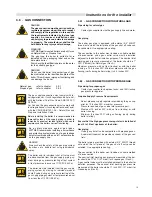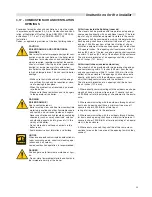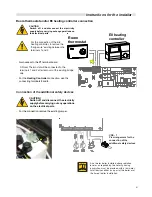
25
Instructions for the installer
3.17 - COMBUSTION AIR AND VENTILATION
OPENINGS
Provisions for combustion and ventiiation air must be made
in accordance with section 5.3, Air for Combustion and Venti-
lation, of the National Flue Gas Code, ANSI Z223.1/NFPA 54.,
or Sections 7.2, 7.3 or 7.4 of CAN/CSA-B149.1-05,
installation
Codes, or appiicabie provisions of the local building codes.
CAUTION
BOILER DAMAGE AND OPERATIONAL
FAILURES
Due to insufficient or improper openings for com-
bustion air and/or ventiiation of the boiler room.
Provisions for combustion air and ventiiation are
always required, regardiess whether the combu-
stion air is taken from the outside (sealed com-
bustion) or inside (room air for combustion).
Insufficient ventilation of the boiler room can lead
to high air temperatures. This can result in boiler
damage.
- Make sure that intake and exhaust openings
are sufficiently sized and no reduction or closu-
re of openings takes place.
- When the problem is not resolved, do not ope-
rate the boiler.
- Please note these restrictions and its dangers
to the operator of the boiler.
WARNING
BOILER DAMAGE !
Due to contaminated air.
- Boiler must be clear and free from combustible
materials, gasoline and other flammable vapors
and liquids, and corrosive liquids and vapors.
Never use chiorine and hydrocarbon containing
chemicals (such as spray chemicals, solution
and cleaning agents, paints, giues etc) in the
vicinity of the boiler.
- Do not store and use these chemicals in the
boiler room.
- Avoid excessive dust formation and buildup.
NOTICE
When one expects contaminated combustion air
(near swimming pools, chemical cleaning ope-
rations and hair salons),
sealed combustion operation is recommended.
DANGER
Fire danger due to flammable materials or liqui-
ds.
- Do not store flammable materials and liquids in
the immediate vicinity of the boiler.
All Air from inside the Building (room air)
The closet shall be provided with two permanent openings
communicating directly with an additional room(s). The total
input of all gas utilization equipment installed in the combi-
ned space shall be considered in making this determination.
Each opening shall have a minimum free area of 1 square
inch per 1,000 Btu per hour of total input rating of all gas
utilization equipment in the confined space, but no less than
100 square inches. One opening shall commence within 12
inches (305 mm) of the top, and one opening shall commen-
ce within 12 inches (305 mm) of the bottom of the enclosure.
The minimum dimension of air openings shall be not less
than 4 inches (101 .6 mm).
All Air from Outdoor (seaied combustion)
The cioset shall be provided with two permanent openings,
one commencing within 12 inches (305 mm) from the top,
and one commencing within 12 inches (305 mm) from the
bottom of the enclosure. The openings shall communicate
directly, or by ducts, with the outdoors or spaces (crawi or
attic) that freely communicate with the outdoors.
The minimum dimension of air openings shall be no less
than 4 inches (101.6 mm).
1. Where directly communicating with the outdoors, each ope-
ning shall have a minimum free area of 1 square inch per
4,000 Btu/hr of total input rating of all equipment in the enclo-
sure.
2. Where communicating with the outdoors through vertical
ducts, each opening shall have a minimum free area of 1
square inch per 4,000 Btu/hr of total input
rating of ali equipment in the enclosure.
3. Where communicating with the outdoors through horizon
tal ducts, each opening shall have a minimum free area of 1
square inch per 2,000 Btu/hr of total input rating of ali equip-
ment in the enclosure.
4. Where ducts are used, they shall be of the same cross-
sectional area as the free area of the opening to which they
connect.






























